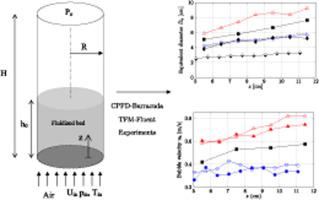Advanced Powder Technology ( IF 5.2 ) Pub Date : 2021-09-04 , DOI: 10.1016/j.apt.2021.08.029 J.I. Córcoles 1, 2 , A. Acosta-Iborra 3 , J.A. Almendros-Ibáñez 1, 2 , C. Sobrino 3

|
This paper presents the results of a 3-D numerical simulation of a freely bubbling fluidized bed, based on the Eulerian–Lagrangian approach, using the software Barracuda (CPFD-Barracuda). The main results obtained were assessed in terms of frequency analysis, bubble pierced length, bubble size, bubble passage frequency and bubble velocity. The results obtained were also compared with experimental data obtained in a 3-D fluidized bed using pressure and optical probes, and with the numerical results using the more common Eulerian-Eulerian approach, implemented in the commercial software Fluent (TFM-Fluent).
The results show that CPFD-Barracuda satisfactorily predicts the global behaviour of bubbling beds with a low computational cost, although it computes smaller bubble sizes and lower bubble velocities than TFM-Fluent and experiments. Additionally, the spectra of pressure and particle volume fraction obtained with CPFD-Barracuda resemble those from the experiments and the TFM-Fluent simulations, but with a larger contribution of lower frequencies. The peaks of the pressure spectra from CPFD-Barracuda are close to those from the experiments and the TFM-Fluent simulations, whereas those in the solid volume spectra seem to be underestimated by CPFD-Barracuda. The results also indicate that the particle fraction threshold value chosen to distinguish bubbles contours notably influences the results of the bubble characteristics, especially for TFM-Fluent, whereas CPFD-Barracuda is less sensitive to this threshold value.
中文翻译:

3-D 气固流化床的数值模拟:TFM 和 CPFD 数值方法的比较和实验验证
本文介绍了基于欧拉-拉格朗日方法,使用软件 Barracuda (CPFD-Barracuda) 对自由鼓泡流化床进行 3-D 数值模拟的结果。在频率分析、气泡刺穿长度、气泡尺寸、气泡通过频率和气泡速度方面对获得的主要结果进行了评估。获得的结果还与使用压力和光学探头在 3-D 流化床中获得的实验数据进行了比较,并与使用更常见的欧拉-欧拉方法的数值结果进行了比较,该方法在商业软件 Fluent (TFM-Fluent) 中实现。
结果表明 CPFD-Barracuda 以较低的计算成本令人满意地预测了鼓泡床的全局行为,尽管它比 TFM-Fluent 和实验计算出更小的气泡尺寸和更低的气泡速度。此外,使用 CPFD-Barracuda 获得的压力和粒子体积分数的光谱类似于实验和 TFM-Fluent 模拟中的那些,但低频的贡献更大。CPFD-Barracuda 压力谱的峰值接近于实验和 TFM-Fluent 模拟的峰值,而固体体积谱中的峰值似乎被 CPFD-Barracuda 低估了。结果还表明,为区分气泡轮廓而选择的粒子分数阈值显着影响气泡特征的结果,尤其是对于 TFM-Fluent,



























 京公网安备 11010802027423号
京公网安备 11010802027423号